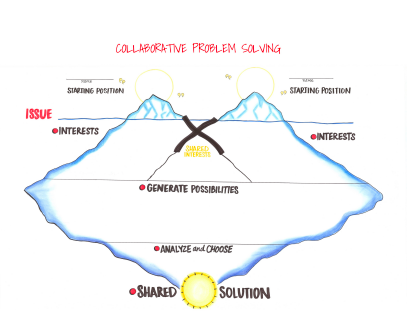
My friend Lynn Carruthers, an accomplished visual practitioner, calls templates ‘handrails in the wilderness.’ She’s right…visual templates are a tool third party impartials (mediators, ombuds, collaborative lawyers, coaches etc.) can use to help guide parties in a dispute to ‘find their way through the tangled forest’ to agreement.
So, what exactly is a template?
A template is a pre-prepared graphic organizer that provides a lightly structured framework where individual thought, or group discussion is captured for use in the process. It’s an invitational, approachable space that often uses imagery to set a tone and/or ground the conversation in a larger visual metaphor.
Of everything I teach, templates are what get dispute resolution practitioners most excited because it’s an easy entree into working visually. Once the template is created, all anyone has to do is capture words into it. There’s no need to draw!
And here’s the magic of how using a template encourages a collaborative dynamic. People contribute more when they can see they’ve been heard. By capturing their important thoughts on paper, it helps parties stay focused on the information that matters to solving their issue(s).
I love watching lightbulbs go on when dispute resolution practitioners recognize that there are TONS of opportunities to design templates that support parties before, during and after they engage in collaborative problem solving. Here are 3 ways I use visual templates in my mediation practice:
In dispute resolution processes, often parties benefit from doing some form of individual preparation before a joint session. Templates can be used to help people reflect thoroughly on their situation and organize their own thoughts.
BATNA/MLATNA/WATNA is a tool often suggested to help parties develop a realistic sense of benchmarks that may help them make a decision to settle later on in negotiations. It asks parties to consider the various possible outcomes (from both parties’ perspectives) and consider the consequences of relinquishing their decision making power if they walk away from mediation (and potentially enter another process).
I developed this template to encourage parties who are very entrenched, or over-confident to develop a more realistic view. I’d found in joint sessions, if parties were losing the resolve to mediate, they often had not thought through the consequences deeply prior to beginning mediation. I also found that parties represented by legal counsel had not often discussed the BATNA/MLATNA/WATNA and costs associated with litigation with their lawyers, so maybe had an unrealistic view of what it would really mean to ‘have their day’ in court. By assigning this template to parties and their counsel to complete before mediation day, this step is more likely happen. This means people to show up to the table with a better sense of reality and resolve to succeed in mediation.
Where there are core parts of your process that you routinely do with most clients, a template can be useful to guide a predictable part of a joint session.

For example, when separating parties must work out parenting issues, it can be helpful to first have a big picture discussion before diving into negotiating the many details in a parenting plan. I developed this template, which I use with parties in a joint session to assist parties in developing a common sense of their child’s needs and envision the future they want to create for their child(ren). Parties see both their thoughts co-existing on the same page, which begins to shift them from “my point of view” to a “big picture” perspective. They can refer back to the future they’re trying to create for their child(ren) to guide them when making detailed agreements.
Often the dispute resolution practitioner is working with a framework for the discussion/process in mind, but that framework is unknown or invisible to the parties. For example, interest based mediation follows a 5 stage process (1. Opening 2. Defining Issues and Setting Agenda 3. Uncovering Interests 4. Generating Options 5. Assessing Options and Agreeing on a Solution).
I developed this template to capture discussions in joint mediated sessions because it makes the framework for problem solving (diverge, then converge) transparent and helps parties understand where they are in the process. Knowing people also experience issues after they leave mediation, I realized it was a handy tool to give parties as a takeaway. The iceberg image makes transparent the steps for having a problem solving discussion, increasing the parties’ ability to replicate the kind of discussion they’ve had in mediation on their own when the need arises in the future.
Now templates aren’t a panacea.
As Lynn also says, “Templates are a tool. They are not a substitute for on the spot skilled mediation or great process design. Templates support these two things, they don’t replace them.” There are also times when they are not appropriate.
Comments